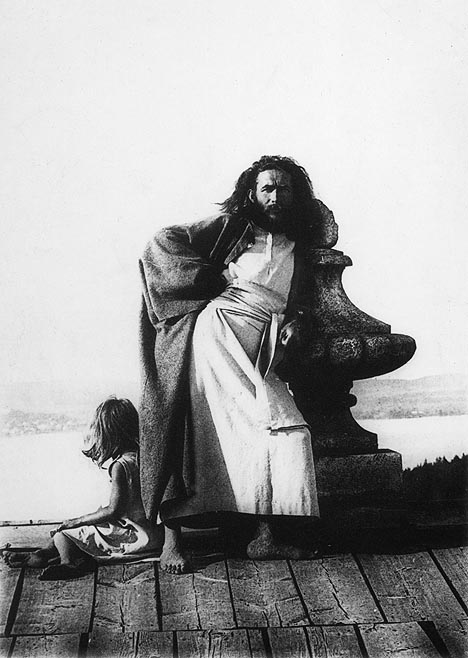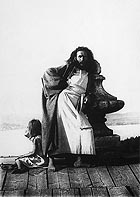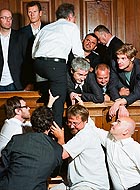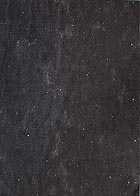
translated and summarized by: Liz Wollner-Grandville,
English summaries September 19 - October 2
Wien Museum Hermesvilla
The Prophet – The World of Karl Wilhelm Diefenbach
07.04.11 to 26.10.11
The Way to Strength and Kohlrabi
It's not so long ago that one would have been called a "Kohlrabi Apostle" if one were a vegetarian. Not that Karl Wilhelm Diefenbach - with his long, white habit, Jesus hairstyle and sandals – didn't invite ridicule. At the end of the 19th century, the proto-hippie from Schwabing was regarded as an attraction, rather like the Viennese, Waluliso, in the 80's.
Vegetarianism, pacifism, nudism and free love without marital constraint were Diefenbach's progressive ideals, some of which have been borrowed from Munich's Villa Stuck and are now on display in the Hermesvilla.
In the 1890's, Diefenbach – always on the run from insolvency and eviction – took part in operating a country commune at Himmelhof, not far from the Lainzer Tiergarten, where – depending on the season and weather – flowing clothes and/or wearing nothing was the order of the day.
It's also not difficult to crack a smile at Diefenbach's self-styled missionary work when faced with his paintings, which favour naked children or youths cavorting happily with lions, stags or simply with Mother Nature. At the same time, the lifestyle reformer didn't just turn out to be a paradigmatic phenomena of the many-faceted reform movements of the turn of the century, but – above all in the silhouette of the 68m long frieze per aspera ad astra which follows on the Biedermeier style – as a defining point in the aesthetics of Art Nouveau. The exhibition also documents that the motif of blithe, dancing and cavorting children and animals was also widely reproduced on lamps, plates, cups and even furniture. The frieze's artistic co-worker, Fidus, together with Joseph Maria Olbrich and Peter Behrens, hoped – in vain – to be appointed to the Mathildenhöhe in Darmstadt. In the end, Fidus' path led to the brown, brackish waters of National Socialism, whilst another Diefenbach apostle, Frantisek Kupka, became one of the founders of abstraction in Modern Art. If nothing else, topicality is prevalent in the excitement of this exhibition that is well worth seeing.
By Iris Meder
Wien Museum Hermesvilla
1130 Vienna, Lainzer Tiergarten
Tel: +43 1 804 13 24
Fax: +43 1 804 13 24
email: office@wienmuseum.at
www.wienmusem.at
Opening hours: 07.04.-26.10.2011 Tue-Sun 10.00-18.00
Christine König Galerie
G.R.A.M. - Hohes Haus
14.09.11 to 22.10.11
The loss of the great gestures
Under the title "Hohes Haus" (Parliament), Günther Holler-Schuster and Martin Behr cite parliamentary conflicts that take a violent turn. Insufficiently detailed international press photos serve as a pattern. Together with extras from the stage world, Holler-Schuster and Behr reconstruct these and reproduce them in Graz's Municipal Council hall. The result presents the doer in a rather ludicrous light. Bodily encroachments appear to the observer as frozen images in an unknown film. The impersonated one gets into an absurd pose.
The artist group, G.R.A. M., known for these "re-enactments" (1) in which, for example, they reconstruct anarchistic scenes from Stan Laurel and Oliver Hardy films, do not, unfortunately, reveal anything about the source of the press photographs to us. We are not informed about the conflict, which wrecks those being impersonated; the context from which this craft draws its motive remains unrevealed to the observer. From the working list, one gathers as provenance that the photos are of the cities of Seoul, Kiev, Taipei, etc. but one doesn't learn anything more exact about the circumstances of the conflict. That's a pity, and it robs this art of a superior content and ultimately also political level.
To isolate situations out of their context and to alienate them is a traditional method of artistic depiction. Admittedly, the wranglings of Holler-Schuster and Behr play with motifs of the classical history of art in their light-dark, in their gesticulations and mannerisms, particularly in painting, but remain primarily in an empty attitude. G.R.A.M.'s work also reminds one of the so-called Tableaux Vivants, a form of art of the "Living Pictures" which came into fashion at the end of the 18th century as a re-enactment of painting and plastic and which finds its representatives in today's contemporary art. For example, in their arrangements of the 70's and 80's, Cindy Sherman and Hannah Wilke thematize the exposure of clichés and feminist matters. In the 80's, Rodney Graham again skillfully parodied neurotic behavior. Up to today, dancers or artists demonstrate the body movement "compliment" as thanks for applause from the public.
How the re-enactment of habits can awaken pleasure was also shown in Christiane Seiffert's photographic work, "Doppelt", presented in 2002 in the exhibition "Tableau Vivants" in the Wiener Kunsthalle. The artist posed on a ladder "chirping" beside a photograph of a bird in a similar pose. That had enigmatical witticism and humour, something that is unfortunately missing in the works of Holler-Schuster and Martin Behr.
By Susanne Rohringer
(1) A catalogue will be available at the exhibition: Re-enactments (1998-2011), Ediciones Poligrafa, Barcelona 2011.
Christine König Galerie
1040 Vienna, Schleifmühlgasse 1a
Tel: +43-1-585 74 74
Fax: +43-1-585 74 74-24?
email: office@christinekoeniggalerie.at
www.christinekoeniggalerie.at
Opening hours: Tue - Fri 11:00-19:00, Sat 11:00-15:00
Galerie nächst St. Stephan
Ernst Caramelle – This time, completely abstract
14.09.11 to 29.10.11
Painting with consistent idea
In the course of revitalizing the old art genres in the 1980's, an impulsive mural art revival took place in Austria. A comprehensible, subversive counter-proposal in the land of post-baroque illusionary art. At that time, Ernst Caramelle, made great impressions with his antique-finished mural works in the form of geometric colour-field paintings in the Graz Art Association where, in the 1970's, he had already attracted attention with a series of ironic video performances.
As capricious conceptualist and pragmatist of the art of ideas, he transported differentiating, traditional and new media into new contexts whereby changeability and fine traces were prevalent and switched between drawing, video, room installation, painting, catalogue or photography.
Caramelle's conceptual approach to painting is apparently divest of every narrative basis. And yet his formalized works try to testify something about perception, adoption of ideas, art and its production requirements.
The invitation cards or the exhibition's poster of 2011 don't cater to a mental exercise but rather to the laconic title “Diesmal Ganz Abstrakt” ("This time completely abstract"). En passant, with such constrained discourse, one thinks preferably about the antithetical, such as the painting with the questionable title "Abstract Painting Must Die Now" by Albert Oehlen or not least Ingo Nussbaumer's label, "Inabstract Art". This finds the notion of abstract merely as an under-developed metaphor for the uncovering of the capabilities and dispositions of the representation of the real and things.
However, in his malpractice, Caramelle not only implies post-moderne scepticism but also the significance of parody. The classical canvas is avoided. His current exhibition is dominated by floor-to-ceiling, flat relief-like mural art in watercolour and pigment. The dividing walls of the white cubic gallery are broken in several places by folded geometric architectonic shapes and, together with a combination of smaller works on paper or wood, lead one to realize that traditional painting is still capable of producing appropriate symbolic forms for the sentiment of the world and things. It divides the rooms, displaces the perspectives and, from a cultural point of view, refers to different contrary production velocities. Parts of the exhibition are, naturally, time-retentive with the sun's "painted" light – the classic in the artist's oeuvres – and further, compositions in chip aesthetic and pointers to the relatively new artistic tool of the small screen "computer" whose realization took seven years. The artist disallows the flood of pictures, which always increases the power of this medium, and remains true to his idea which time will evaluate over a longer period.
By Goschka Gawlik
Galerie nächst St. Stephan
1010 Vienna, Grünangerg. 1/2
Tel: +43 1 5121266
Fax: +43 1 5134307
email: galerie@schwarzwaelder.at
www.schwarzwaelder.at
Opening hours: Mon-Fri 11.00-18.00, Sat 11.00-16.00
Startgalerie in the MUSA
Maureen Kaegi - Where the surface is
09.09.11 to 06.10.11
Graphite and Stardust
A monumental pencil drawing over three metres high and what appears to be an even more enormous crumpled piece of paper dominate this show, which has only six works on display. In an "all-over" manner, the drawing shows points, which become whiter and thicker against the dark grey area of a starry sky. Whereby the poetical power of this work emerges, in essence, through what is for a pencil drawing an extremely large piece of paper in relation to the entirety of the room. Thus, the exhibition should preferably be seen as an entity and less than six different works. Above all, the crumpled piece of paper – probably in similar format – engenders a pleasant excitement as an opposite pole to the above-mentioned "starry sky". To gaze into the never-ending space against this boulder-like "paper bundle" makes one feel very small.
It's the phenomena (which the artist has assumed) that what can be seen on the surface is not that which is allegedly meant at a deeper level. The same can be seen in the work "Branch 1" which shows, indistinctly, a bare tree by night whose branches almost seem to cut the dark night sky like streaks of lightening.
A large-format wall drawing which, for the most part, consists of a thick, very complex-structured layer of graphite, reminds one in its materiality - as well as in its relatedness to the room - of Richard Serra and his lead sculptures. Here, it would appear, material, form and technique are taken very seriously but are not seen as a single content of art. Therefore, the works of the artist, born 1984, serve as projection surfaces for the ideas and feelings of the observer, and create room for one's own thoughts as opposed to those, which the artist seeks to exemplify.
By Wolfgang Pichler
Startgalerie im MUSA
1010 Vienna, Felderstraße 6-8, next to the Town Hall
Tel: +43 (0)1 4000 8400
email: musa@musa.at
www.musa.at/startgalerie
Opening hours: Tue, Wed, Fri: 11:00-18:00; Thu 11:00-20:00; Sat 11:00-16:00
Mehr Texte von translated and summarized by: Liz Wollner-Grandville


 Teilen
Teilen





